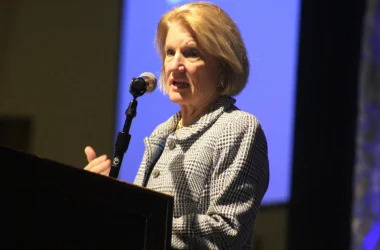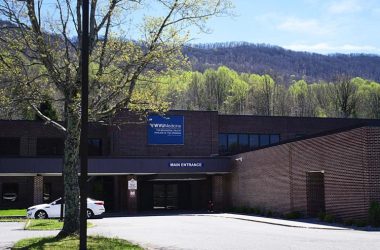By RICK STEELHAMMER
Charleston Gazette-Mail
CHARLESTON, W.Va. — Fifty years ago Friday, just before 5 p.m., 37 vehicles occupied by 64 people — a blend of local Christmas shoppers, long-haul truckers and commuting workers — were crossing the Ohio River between Point Pleasant and Kanauga, Ohio, on the Silver Bridge.
As a stoplight on Sixth Street in Point Pleasant kept a long line of southbound traffic stalled on the span, a noise, described by some as a very loud gunshot and by others as a whooshing roar, echoed through the Mason County river town.
An instant later, the bridge’s deck pitched sharply sideways and down, dumping all but six of the cars and trucks crossing the span into the icy waters or narrow strips of shoreline below. As the vehicles began to sink, they were pummeled by a deadly shower of steel support beams as the bridge’s suspension structure collapsed atop them, starting from the Ohio side.
“It was like a chain reaction,” said Charlene Foster, who lived near the Ohio approach to the bridge and witnessed the disaster. The collapsing bridge “snaked its way across the river,” she said in a newspaper interview the following day. “It did not fall all at once. My God, it was horrible.”

“Now I know what it’s like to drown — I expected to die,” Bill Needham, a North Carolina trucker, told a Charleston Gazette reporter the day after the collapse.
Needham’s Roadway rig had been idling near the middle of the bridge when it collapsed and pitched the truck into the river, where it sank to the bottom.
“I was running out of breath when I noticed a little crack in the window and finally forced it down,” Needham said. “I managed to grab a box and hang on,” riding it to the surface and an eventual rescue.
Needham, like a number of others who were on the bridge that night, sensed a vibrating sensation coming from the bridge just before the collapse.
“He knew something was going to happen,” said Jack Fowler, director of the Point Pleasant River Museum, where displays of Silver Bridge items, including a 17-foot-long model of the bridge and the vehicles on it at the time of the collapse, dominate the second floor.
“He sensed that the bridge was going down and told his truck’s other driver, who was in the bunk behind him, that they should get out of the truck,” Fowler said. “But there wasn’t enough time.”
Needham, whose co-driver died in the collapse, is one of only three still-surviving people thrown into the river during the collapse. He is expected to be among those attending a 50th anniversary memorial ceremony for the Silver Bridge Disaster at 11 a.m. Friday.
The ceremony will take place on Sixth Street in downtown Point Pleasant, near the site where the ill-fated bridge once connected with the West Virginia shore. A reception will follow in nearby Trinity United Methodist Church’s activities room.
A second ceremony will take place at 5 p.m. Friday at the end of Sixth Street, where the names of those who died in the collapse will be read and searchlights from a pair of towboats will trace the skies above the river where the bridge once stood.

A 17-foot-long model reproduction of the Silver Bridge and the cars that were on it when it collapsed Dec. 15, 1967, can be found at the Point Pleasant River Museum.
KENNY KEMP | Gazette-Mail photos
“Today, not a trace of the bridge can be found on either side of the river,” Fowler said. “The highway people back then thought it would be an upsetting reminder to people who lost loved ones to leave anything standing. Everyone in town had some personal attachment to at least one person on the bridge.”
But Fowler said he wishes a portion of the approach ramp on the West Virginia shore had been preserved as a tangible memorial to those who died 50 years ago and to help tell the story of how the collapse changed his town forever.
“We need to keep the Silver Bridge story alive so that children growing up here know the full story,” said Ruth Fout, Fowler’s administrative assistant.
The Silver Bridge, nicknamed for the shiny aluminum paint with which it was coated, opened on Memorial Day of 1928. It was built by the West Virginia-Ohio Bridge Co. and its subcontractor, American Bridge Co., to carry U.S. 35 traffic across the Ohio.
The 1,760-foot-long, two-lane crossing made a straighter shot and a shorter trip for truckers from the Virginias and Carolinas to haul raw materials and finished products to and from factories in Columbus and Northern Ohio. Backers of the span, who initially operated it as a toll bridge, promoted it as the “Gateway to the South.”
The new bridge also routed 4,000 or more vehicles a day through downtown Point Pleasant, causing a boom in the development of cafes, consumer goods shops, service stations and other small businesses.
While the original design for the bridge called for conventional wire cables to support its traffic deck, its builders opted for an alternate, cost-cutting approach that replaced the support cables with a chain of steel eyebar links.
The chain consisted of bars of steel shaped like box-end wrenches that were 2 inches thick, 12 inches deep and 35 to 45 feet long. Cylindrical steel pins 11 inches in diameter linked the circular “eyes” in the eyebars into a support chain.
According to the state Department of Transportation, the bridge at Point Pleasant was described as “the first of its type in the United States” in a 1929 issue of Engineering News Record.
A bridge of a similar design built by American Bridge in Florianapolis, Brazil, in 1924, still stands, but it is closed to traffic pending completion of a major renovation that includes replacement of its eyebar chain.
While the Silver Bridge was under construction, an identical toll bridge was being built 75 miles upriver at St. Marys by the same engineer, contractor and fabricator, using the same shop drawings.
That bridge opened five months after the Silver Bridge’s debut and was ordered closed three days after the collapse due to its design and construction similarities. It reopened in February 1971 and carried traffic for 10 months before state and federal highway officials opted to tear it down and replace it with a more conventional design.
To determine the cause of the Silver Bridge collapse, its components were salvaged from the Ohio and hauled to the West Virginia shore a few hundred yards downstream from the mouth of the Kanawha River. There, they were loosely pieced together, much in the way an aircraft is reassembled following a crash to determine its cause, by the National Transportation Safety Board.
“It was one of the most thorough incident investigations of all time,” said Tracy W. Brown, district bridge engineer for the state Division of Highways’ District 1. “Pretty much all of the bridge was recovered, including 90 percent of the deck. Nearly all of the structural elements were retrieved from the river.”

Part of the Silver Bridge is on display at the museum.
KENNY KEMP | Gazette-Mail
Meanwhile, traffic that normally would have traveled over the Silver Bridge was rerouted to the Pomeroy Bridge, 14 miles north, or to the U.S. 52 Bridge, 42 miles south. A ferry service was established between Point Pleasant and the Ohio shore, and a shuttle service began operating on the New York Central Railroad Bridge just upstream from the collapsed highway bridge.
Despite the temporary fixes, business suffered immediately from a sharp decline in traffic moving through Point Pleasant.
After economic losses to the town were estimated at $1 million a month early in 1968, President Lyndon Johnson ordered the launch of a federal-state partnership to replace the failed bridge as soon as possible.
To save time, preliminary drawings prepared for a new bridge carrying Interstate 20 over the Mississippi River at Vicksburg, Mississippi, were borrowed and altered to fit the Point Pleasant area’s topography.
“The new bridge opened two years to the day after the Silver Bridge collapsed,” Fout said.
But the new span, dubbed the Silver Memorial Bridge, was built about 1 mile south of Point Pleasant, making it more convenient for those traveling U.S. 35 to buy food, gas and lodging in Gallipolis, Ohio, than to exit and detour at Point Pleasant.
On April 6, 1971, the NTSB officially ruled on the cause of the Silver Bridge collapse. After painstaking analysis, it was determined that a microscopic pit in the surface of a single eyebar installed near the Ohio shore had grown “into a pair of 4 millimeter cracks as the result of the joint action of stress corrosion and corrosion fatigue.”
On Dec. 15, 1967, the cracks became a fracture, causing the eyebar link to fail.
“With the chain thus broken, the structure’s design made total collapse inevitable,” the investigation concluded.
Other bridges relying on eyebar suspension chains that remain in use today were designed with multiple eyebars at each joint, providing a degree of redundancy the Silver Bridge lacked.
The final recommendation in the investigation report called for creation of a national bridge inspection system requiring trained inspectors to examine all bridges in the state and federal highway inventory once every two years.
The National Bridge Inspection program was created in 1968 in direct response to the Silver Bridge disaster.
“The Silver Bridge collapse was a national wake-up call and inspired a much more aggressive effort to inspect and maintain bridges across the country,” said Brandye L. Hendrickson, acting federal highway administrator, who will be among state, federal and local officials speaking during Friday’s ceremony. “In fact, this tragedy propelled the nation into an era of bridge safety.”
“I hope the people who lost loved ones in the collapse can take some degree of comfort in knowing that a lot of good came out of this tragedy,” Brown said. “A lot of lives have been saved across the country since Dec. 15, 1967.”

A historic marker in downtown Point Pleasant provides an overview of the Dec. 15, 1967, Silver Bridge Collapse.
KENNY KEMP | Gazette-Mail
In West Virginia before the Silver Bridge collapse, “We had no special training for bridge inspectors and no bridge departments in any of our highway districts,” Brown said. “Now, each district has a bridge inspection department and an engineer.”
Brown supervises inspections on 1,200 bridges, including the Silver Memorial Bridge, in five West Virginia counties. He said when he first got out of college and began working for the Division of Highways, he had a supervisor who gave him a photograph showing debris from the aftermath of the Silver Bridge collapse.
“He told me, ‘If you ever find yourself working on a Friday and thinking about taking a shortcut to get off early, take a look at that picture,’” Brown said. “I don’t really need to, because I think about the Silver Bridge every day.”
See more from the Charleston Gazette-Mail




